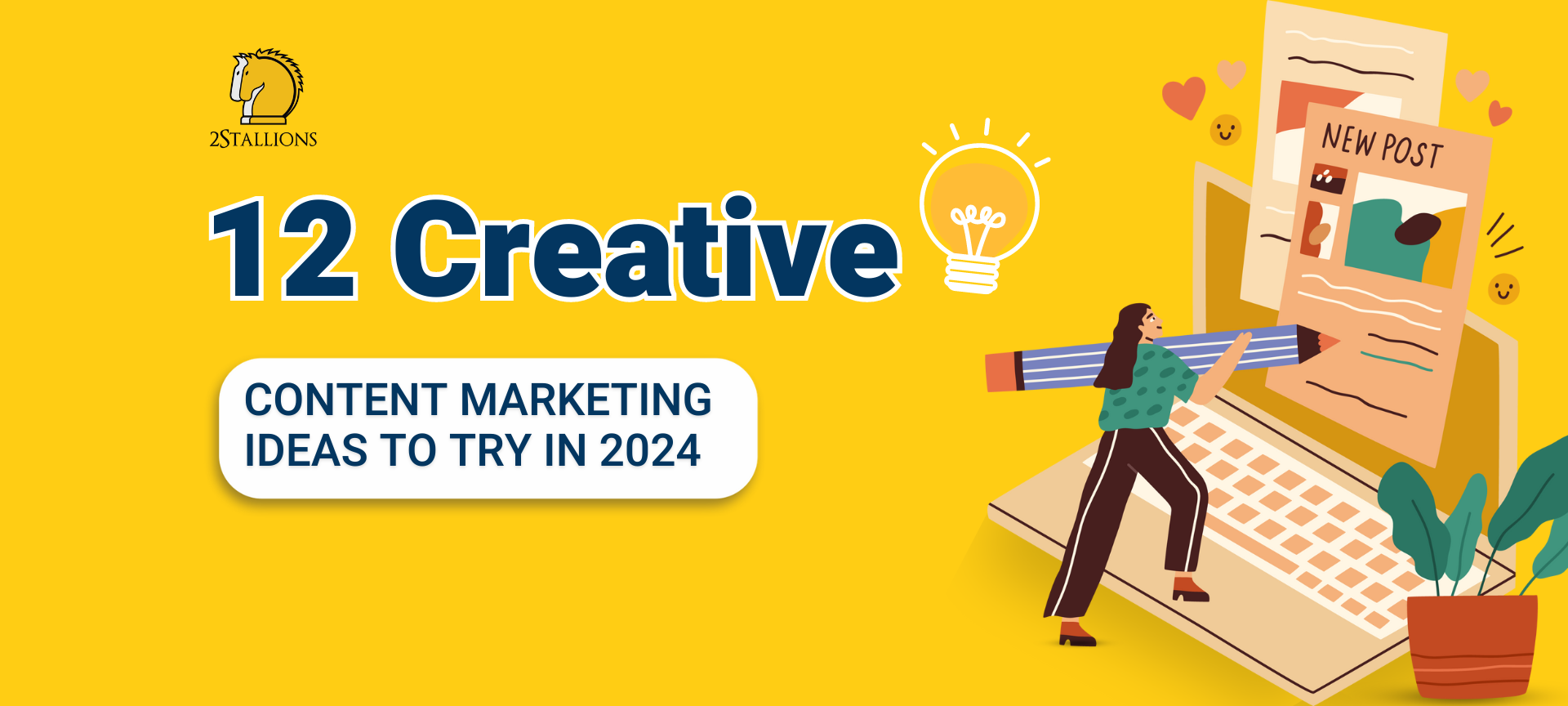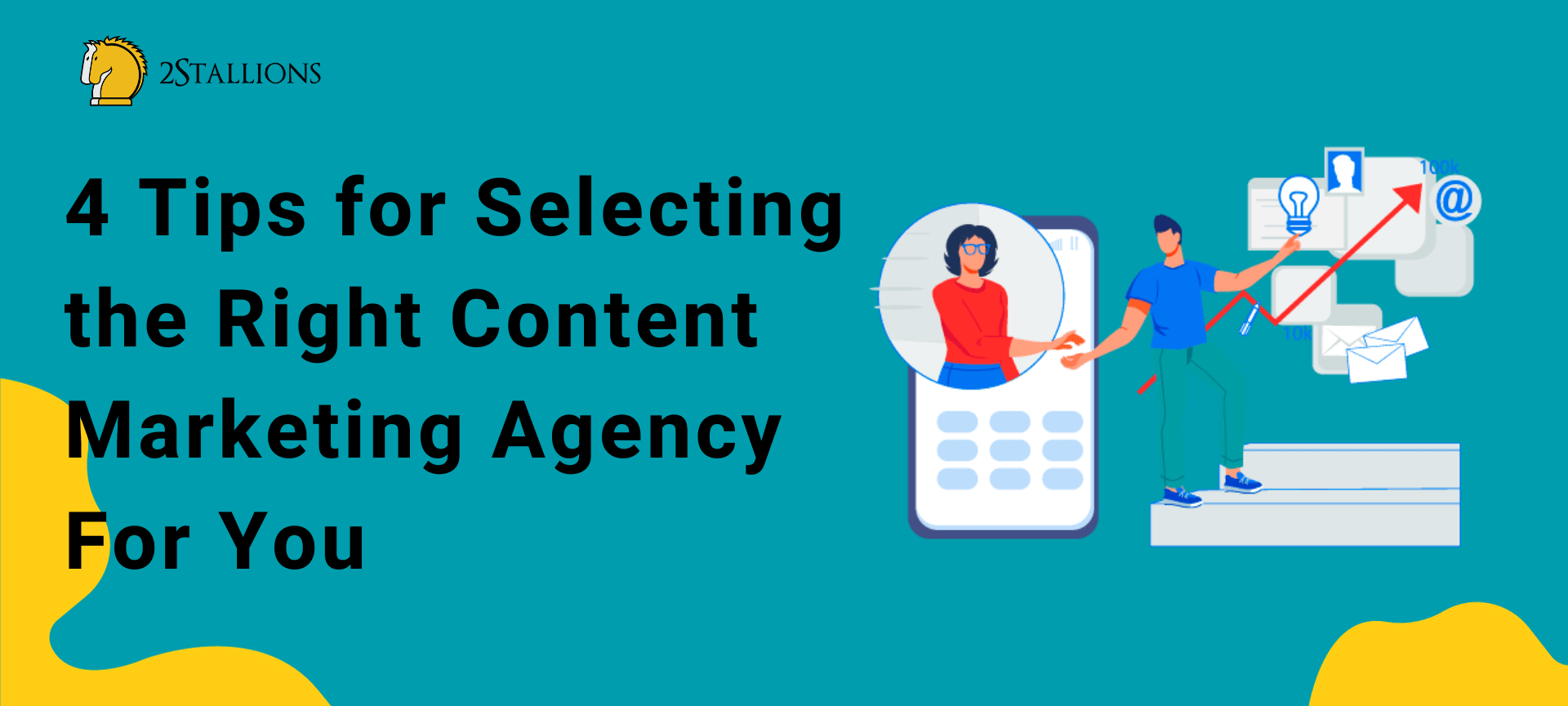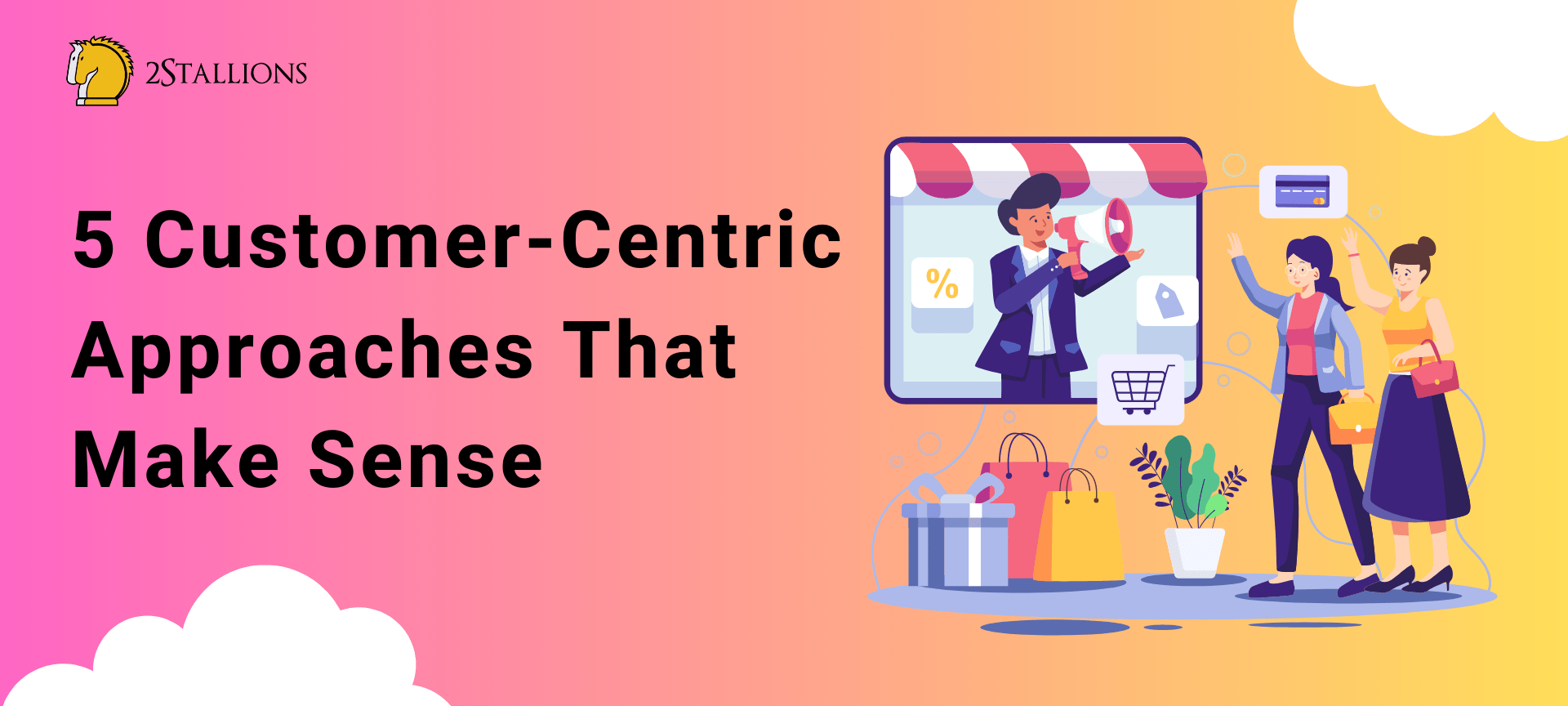Content
SHARE

Website visitors who come for information, whether for research or purchase motivation. Targeted content is key for successful sales funnels, with over 85% of brands reaping the rewards from content marketing. Engaging blogs, videos, and social media posts effectively position products as solutions. Quality content establishes brand authority, fostering trust and driving increased leads and conversions.
Despite the cliché, "Content is King" remains true for blogs, infographics, and videos—powerful brand identity, audience connection, awareness, and lead generation tools. Effective communication relies on impactful words and visuals, making content indispensable to any marketing strategy. Businesses lacking a robust content plan should take action now to enhance awareness, generate leads, and boost sales. Discover more about crafting compelling content for your business.
What Exactly Is Content Marketing
In essence, content marketing revolves around using relevant and valuable content to attract and retain visitors, eventually turning them into paying customers. It aims to capture audiences' interest and solve their pain points by creating content that serves these goals. This blog you're reading right now is a form of content marketing. That online survey you answered, the email you opened, and the social media posts you liked are other forms of content marketing.
Other types of content marketing include
- case studies,
- infographics,
- webinars,
- podcasts,
- videos.
Content Marketing is Not Just for the Big Brands
Small businesses and startups aren't the only ones who can benefit from content marketing. Numerous multinational companies use content to engage their audience in different social media platforms and avenues that allow their audience to provide feedback. In this manner, they collect information to improve their products and services. For instance, one might think that Rolex can go decades without making marketing efforts due to its timeless brand. However, those who run Rolex know that if a brand doesn't keep up with the pace and stay relevant, a competitor can easily swoop in and steal the spotlight. Now, what exactly can you do to market a product that is already successful?
 Using social media platforms like Instagram to keep their products relevant and within everyone's line of sight. Through meticulously crafted photos showcasing their iconic watches, Rolex aims to display their products and convey a visual narrative that embodies a sophisticated lifestyle. This approach serves as a subtle yet powerful reminder to their target audience about the timeless allure associated with the Rolex brand.
Using social media platforms like Instagram to keep their products relevant and within everyone's line of sight. Through meticulously crafted photos showcasing their iconic watches, Rolex aims to display their products and convey a visual narrative that embodies a sophisticated lifestyle. This approach serves as a subtle yet powerful reminder to their target audience about the timeless allure associated with the Rolex brand.Why Content Marketing Works?
Content marketing is highly effective for three reasons: it provides value to audiences, builds trust over time, and attracts the right target audience for your brand. For instance, consider blog articles tailored to address a particular audience's needs, pain points, and desires.
Your blog site establishes authority when your articles successfully address and solve readers' problems. This, in turn, encourages repeated visits, enabling your brand to engage with better leads and customers. If you remain unconvinced about the efficacy of content marketing, consider the following statistics:
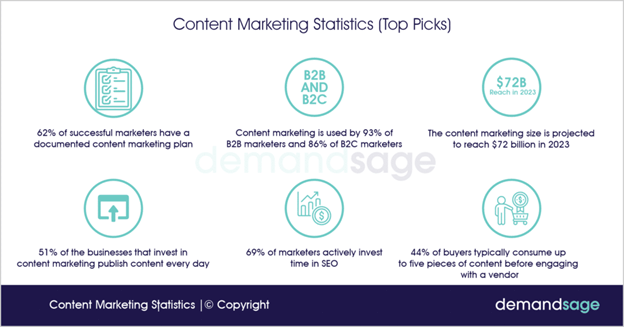
Why Should You Invest in Content Marketing?
1. Great Potential for Significant ROI
Returns from content marketing manifest in various ways, including customer acquisition, brand visibility, reputation, and inbound traffic. Marketing experts agree that a well-executed content marketing strategy has the potential for higher ROI, as illustrated in the graph below. While not every viewer translates to a direct dollar, your company benefits in diverse forms through effective content marketing.
2. Inbound Marketing (Pull Marketing Instead of Push)
In marketing, precise investments are crucial. Content marketing allows you to target potential buyers more likely to convert to your brand. Someone uninterested in your industry is unlikely to click through your link or advertisement, diminishing the effectiveness of promotions aimed at such individuals. Content marketing operates as inbound marketing, pulling in engaged audiences rather than pushing promotions to disinterested parties. This targeted approach ensures a more efficient allocation of marketing resources.
[thrive_leads id='8298′]
Content Marketing Examples to Inspire Your Next Campaign
Coca-Cola's "Share a Coke" Campaign
Coca-Cola personalised its cans with 250 of the most common names, and people worldwide went crazy searching for a can bearing their name. The campaign was a major success because it appealed to human emotions, inspiring shared moments of happiness among friends and family. In Australia alone, the soft drink manufacturer sold more than 250 million (that is 10 times its population size!) bottles and cans within 3 months.
Superdrug challenges beauty standards with the campaign: "Perceptions of Perfection Across Borders."
Superdrug Online Doctor is a website offering prescription and medical consultation services. The brand asked designers from 18 countries to retouch a woman's photo according to their country's beauty standards. The project aimed to understand potentially unrealistic beauty standards better and see how pressures on women's bodies vary worldwide. The project was a success because of the body positivity message it left: there's no such thing as the perfect body. These pictures quickly made headlines when first published and sparked many conversations online, boosting Superdrug's brand awareness.

BuzzFeed Tasty Facebook page – Building a juggernaut with short video content
BuzzFeed's instructional cooking arm, Tasty, is one of the biggest publishing brands on Facebook, and it's also the juggernaut behind the success of BuzzFeed's video marketing. Tasty consistently captured people's interests by publishing recipes and other food-related content. The brand also began the unique 60-second video format, making it popular on Facebook feeds. In September 2016, Tasty's main Facebook page was the third-biggest video account on Facebook, with nearly 1.7 billion video views. Today, Tasty has grown into a multi-stream revenue model with over 100 million followers, receiving an average of 300,000 views for each of its new videos.
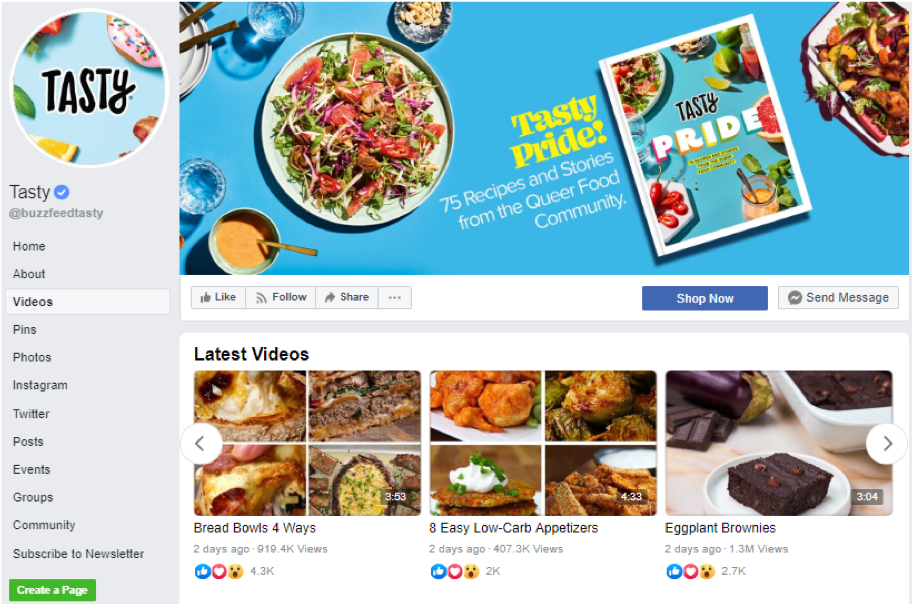
Optimising Content Marketing Impact
Content marketing is a potent tool for driving returns and aligning seamlessly with broader marketing strategies. To assess its effectiveness, seamlessly integrate content marketing into the core of your overall strategy, relying on analytics to optimise outcomes. Explore the symbiotic relationship between content marketing and email campaigns, repurposing well-received social media content to enhance email marketing and improve landing page conversions.
A robust content marketing strategy profoundly influences social media campaigns. Regularly publishing informative articles on your website can be transformed into engaging social media posts, attracting leads and cultivating increased followers, viewership, and a robust brand identity. Measure content marketing success by tracking engagement, conversion rates, and its cross-channel impact on other marketing efforts.
Building Brand Authority (Thought Leadership)
Elevate your brand's profile with high-quality content, positioning your business as a primary information source in your field. An effective content marketing strategy establishes authority and reliability, crucial elements in marketing and advertising.
Imagine operating a fitness centre and implementing content marketing by consistently posting SEO-optimised blog posts. As your website climbs search engine ranks, individuals seeking fitness solutions discover your business. Your fitness tips become their go-to solutions, transforming readers into customers. Compelling content swiftly fosters trust with consumers, creating a reliable and trusted resource in the minds of your audience.
Enhancing Conversions Through Lead Nurturing
Guide your target audience effectively through the sales funnel with tailored content aligned with their preferences at each buyer's journey stage: awareness, consideration, and decision. For instance, a fitness hotspot with an active content marketing campaign can target a specific demographic, consistently offering weight loss tips and healthy recipes to build awareness, ultimately increasing the likelihood of conversions over time.
 How to Create Content That Works for Your Brand
How to Create Content That Works for Your Brand
Remember, content is an essential piece of information. All the information presented in it can help you succeed at persuading and entertaining your readers. With that in mind, it is important to create a content marketing strategy that focuses on producing quality content.
There are 4 qualities to a great piece of content:
 1. It Should Be ReadABLE
1. It Should Be ReadABLE
First things first, your content should be readable. It should be easy on the eyes. This means it should meet the following readability factors: font size, text and background colour, white space, and more. You can't expect your target audience to stay on your website if your content is written in tiny fonts. Troublesome colour combinations can also result in headaches, which can tune your readers out in the first few minutes of their site visit.
Also, white space should be your friend. Ensure the column width, vertical spaces between lines, and space around the images aren't too tight for easier reading. For content to be readable, it should also be easy to understand. The audience's attention span keeps shortening over the years. That's why you should convey your message simply to avoid alienating readers in the first few minutes or seconds.
Secondly, follow the KISS principle. Keep it short and simple. Steer clear of complex words and jargon to get your message across. It's also ideal to reduce the length of your sentences. While there's no definitive rule on the ideal length of a paragraph, a great way to paragraph would be around ideas. Split your paragraphs into sections to make chunks of information easy to read.
 2. It Should Be ShareABLE
2. It Should Be ShareABLE
The best content gets more eyeballs not only because it's readable but also because it's shareable. Often, content shareability depends on one significant factor: the topic itself. If you want to get your content shared, come up with content ideas that resonate well with varied audience types. You can begin your topic research by looking into emotions, trends, and identity.
Creating content that elicits excitement, joy and awe can make your brand or campaign viral. Strike these positive chords to connect with your audiences emotionally and attract more likes, clicks, or shares. Finding trending topics and building upon them is another way to make content shareable. Provide your target audience with content that speaks to their interests, which may help inspire discussion and connection among like-minded individuals.
Let's say you're targeting people who love to travel. This type of audience has various interests—destination, experience, food, etc. You may write a blog article listing vacation spots and activities in a specific location. People are also more likely to share content on their social media profiles if they can relate to and see themselves in it. Try to understand your target audience's beliefs and create content affirming their viewpoints.
3. It Should Be ActionABLE
For a content marketing campaign to be effective, the content should not only spread information to a specific audience. Still, it should also prompt action and explain to the reader how they can achieve a certain objective. This is known as actionable content. You must understand your prospect's dilemmas or problems when creating actionable content. You must recognise these problems and provide answers, solutions or helpful advice.
So, how do you create this kind of content?
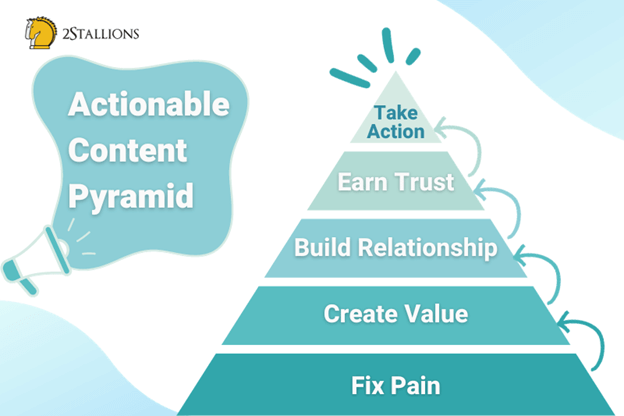
Also, actionable tips backed by real-life examples can convince your readers to take action. Include examples and statistics within sections of your posts to make your content trustworthy. Lastly, use clear calls-to-action (CTAs). Keep them short and sweet, but ensure you convey the message while evoking a sense of urgency.
4. It Should Be MemorABLE
Great content leaves your audience in awe. It lets readers hang on to your words or message for a moment and a long time. Tapping into a single emotion, such as happiness, sadness, anger or fear, is one way to make content stick with your target audience. A study conducted by Psychology Today found that people respond to the emotional part of the ads rather than the text itself.
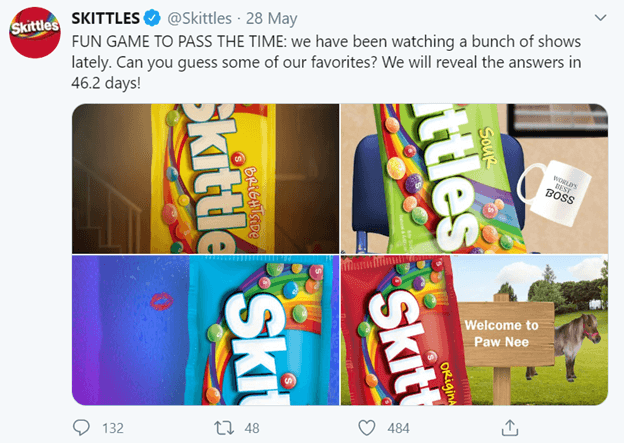
That is why tear-jerking and humorous campaigns tend to leave an impact on audiences. The intense emotions they convey help to engage, influence, and inspire people, making the campaign viral and memorable. Apart from using emotional triggers, there's another method to leave your audience awestruck- a cliffhanger. There are a few steps to create cliffhanger content. First, begin with writing strong and magnetic headlines. Your headline should give readers a glimpse of your content's purpose. Next, craft a promising introduction. Tell readers why they should care about your post and promise them solutions to their problems.
Then, leave them with a question that will make them reflect on how they can implement the knowledge you provided. The question should leave them wanting more and clicking your call-to-action (CTA) button. As summer approaches, your audience, inspired by your content, starts considering fitness goals. They may attempt self-improvement by revisiting your videos and exploring your website for more content. However, realising the need for professional guidance, some will seek your expertise to navigate their fitness journey, recognising your brand as the solution.
Content Marketing: The Key to Marketing Success
Content marketing is unmatched in its effectiveness within modern business strategies. Among the various benefits, one truth prevails: it is the most potent way to achieve goals in today's dynamic landscape. Functioning as the bridge between services and customers, content marketing leverages information for conversion and research. Its efficiency not only distinguishes but positions your business as an industry leader. Effective content marketing drives inbound leads, establishes brand awareness, and expertly guides individuals through the sales funnel.
Whether focusing on short-term solutions or long-term strategies, impactful content leaves a lasting, positive impression, significantly boosting the potential for high return on investment (ROI). Behind every successful brand are high-value content pieces crafted to promote the business. To stand out or keep up with your competition, create readable, shareable, actionable, and memorable content—qualities encapsulated by the word "ABLE." At 2Stallions, we recognise the intrinsic value of content marketing and are here to help develop captivating and sales-driven content.
Originally published: 10 June 2020
Updated: 1 January 2024
Unlock Your Brand's Potential With an Expert Content Marketing Company. Elevate Your Online Presence, increase engagement, be at the top of the minds of your targetted users, and Drive Results. Get in touch with us today!
Frequently Asked Questions About Content Marketing & How to Do it Effectively
What is Content Marketing, and How Does it Differ from Traditional Advertising?
Content marketing involves creating and distributing valuable, relevant, consistent content to attract and engage a target audience. Unlike traditional advertising, content marketing aims to provide information and build trust rather than directly promote a product or service.
How Can I Identify the Right Content for My Target Audience?
Identifying the right content for your target audience involves understanding their needs, preferences, and pain points. Conducting market research, analysing customer feedback, and leveraging data analytics can help you create content that resonates with your audience and adds value to their experience.
What Channels and Platforms Should I Use for Effective Content Distribution?
Effective content distribution involves selecting channels and platforms that align with your target audience's behaviour. This may include your website, social media, email marketing, and industry-specific platforms. Understanding where your audience spends their time online helps optimise your content distribution strategy.
How Do I Measure the Effectiveness of My Content Marketing Efforts?
Measuring the effectiveness of content marketing requires tracking key performance indicators (KPIs) such as website traffic, engagement metrics, conversion rates, and customer retention. Utilising analytics tools and regularly assessing the impact of your content helps refine your strategy for better results.

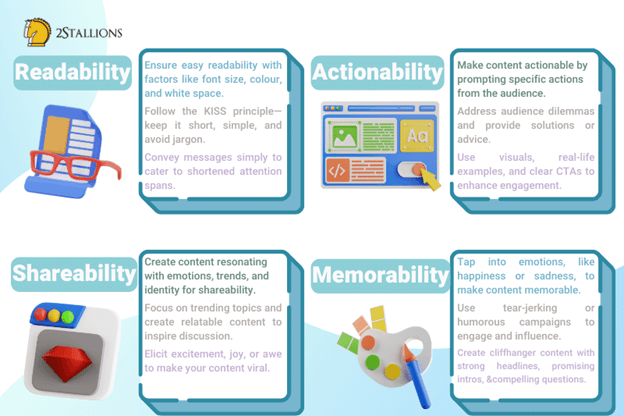 How to Create Content That Works for Your Brand
How to Create Content That Works for Your Brand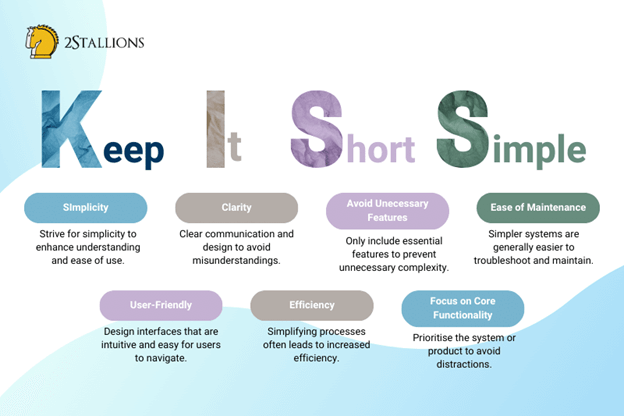 1. It Should Be ReadABLE
1. It Should Be ReadABLE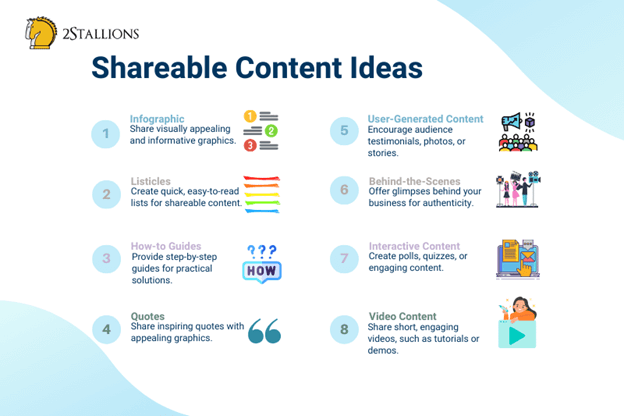 2. It Should Be ShareABLE
2. It Should Be ShareABLE


